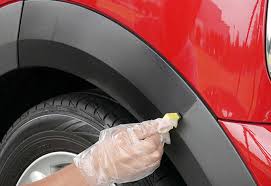Plastic and trim of your vehicle may fade with time or even lose its original shine due to exposure to the sun, severe weather conditions, and road dirt. No matter, whether it is the outside trim that has become gray, or the interior panels that have become dull and battered, restoration of the surfaces can significantly improve the look of your car. Most car owners do not think about maintaining a good appearance of trim and plastic parts, but using effective methods; one can restore them to a factory-new state.
The restoration of the trim is not only aimed at making the vehicle look good but also to preserve the materials of the vehicle to further wear. Worn out plastic could break or deteriorate at a higher rate especially when it is not treated hence costly remedial work will have to be conducted or a new set is bought. One of the central repairs of professional car detailing is restoring trim and plastic due to its ability to take the finished polished look of a well maintained car and add value to it in the long term.
Understanding Why Trim Fades
Fading of plastic and rubber trims happens primarily as a result of sun ultraviolet rays (UV-radiation). Continual exposure destroys the film on these materials leading to oxidation and discolouration. Consequently, black trim might become gray or chalky and other colored plastic may appear bleached or streaked. Besides exposure to the sun this decay may be increased by severe chemicals in cleaning solutions or the use of winter road salt.
Trims found inside the car, particularly in areas close to windows, or the sunroof, can also fade as well with time. Although cleaning procedures of the interior of the car will prevent the accumulation of dust and other filth on various surfaces, it does not necessarily prevent fading. Plastic and rubber may further lose some essential oils by use of wrong products, which accelerates the process. This is the reason why trim- safe cleaning and restoration methods have to be employed.
Cleaning Before Restoration
Car detailing also thoroughly goes through the process of removal of any chips, dirt or any other accumulated materials before trying to restore any trim or plastic. Washing out the dirt, grease, and age-old vacuums upon the items enables the restoration product to fuse and act constructively. Particularly, the plastic surfaces, especially those on the interior, should be treated by a soft cleaner that is specially formulated to handle plastics used in automobiles. Do not apply harsh solvent or general cleaners that may dry or otherwise harm the material.
One way of removing the embedded dirt on textured plastic surface is using a soft-bristle detailing brush. To scrub it, outside trim, in particular, might benefit by some pressure washing to dislodge loose particles. After cleaning, make sure the area is completely dry. Leaving any moisture on the surface may hamper the performance of trim restoration products and it might give an uneven or streaked appearance.
Choosing A Trim Restorer
Restorative products that fix faded plastic are numerous with some being a simple water-based dressing to more complicated silicone-gelled protectants and even ceramic trim restorers. The choice of the product relies on the state of the trim, interior or exterior, and the duration you would like to use the results. In cases of heavily faded exterior plastic, a long lasting UV complex resisting formula is generally the answer.
Interior trim, however, can be improved in terms of non-greasy and low-shine products that will not invite dust to the surface. The products must also be safe to use in other surfaces which are typical in the cabin like vinyl or rubber. Using the labels and adhering to the usage labels would yield the most favourable outcome. When detailing cars, use of high quality restoration products is a sign of professionalism in handling and maintenance.
Applying The Product Correctly
Application is half the game and so is the product selection. Apply the restorer to the surface using foam applicator pad, microfiber cloth or detailing sponge and spread it over the surface to evens as much as possible. One should also not apply too much since this may result in a sticky mess or uneven layer. As an exterior trim, ensure you use the product in the shade so that it may not dry up too fast or leave marks.
Ensure that the product rests to enable it to soak up at an appropriate time. Thereafter, wipe off the excess using a clean microfiber cloth. Sometimes more coats could be required in deeper restorations. Watch about painted surfaces and glass, as to staining. Take your time and be adherent to obtain a more homogenous outcome and a more professional-like finish.
Maintaining The Restored Finish
After the trim is back, one should take care of it to ensure that the results become permanent. It should be washed regularly in mild soaps and dried using safe drying methods to save against the accumulation of dirt that would dull the finishing. To maintain an interior trim, your monthly routines should include, occasionally car interior cleaning services is needed to maintain the enhanced shape and prevent UV impacts through windows.
It is also worth protecting the goods using the help of protective products that include UV blockers and add another safeguard against the fading in the future. It can be applied after a few weeks or months, depending on the durability of the product. When feasible, do not park the vehicle in the direct sun and consult the options of covering surfaces in the shade or covering the car in car covers (less wear). The most important thing is carrying out regular maintenance to enhance the longer life of the restoration work.
When Professional Help Is Needed
It might not be possible to simply restore some of the plastic and trim surfaces and advanced treatments may be necessary. Professional car detailing options can find a solution in such cases such as dyeing the plastic or trim-specific ceramic coating. The options are usually more permanent because they require advanced equipment and experience and thus, a more permanent solution than the consumer grade.
Other possible options of professional detailing include heat processing or surface preparation processes, which are guaranteed to bond restoration materials deeply. When repairing fancy cars or painted cars that have a lot of fading, it might pay to seek professional assistance since there can be a certain peace of mind and better outcomes are achieved. Regardless of how you get to do it, whether you do the restoration at home or a detailing service does it, restoring the trim and plastic on a car is one of the best ways to make your car look a lot better without an expensive makeover.
Conclusion
Reviving old trim and plastic is a very nice investment in the appearance and condition of your vehicle. Given the proper preparation, proper selection of products and proper techniques, that factory appearance can be restored and the durability of exterior and interior parts can be prolonged. When trim restoration is a vital component of car detailing, it increases the quality and the cleanness of your car. With subsequent car interior cleaning and protective washing, you may ensure keeping the trim in shape long after years.

